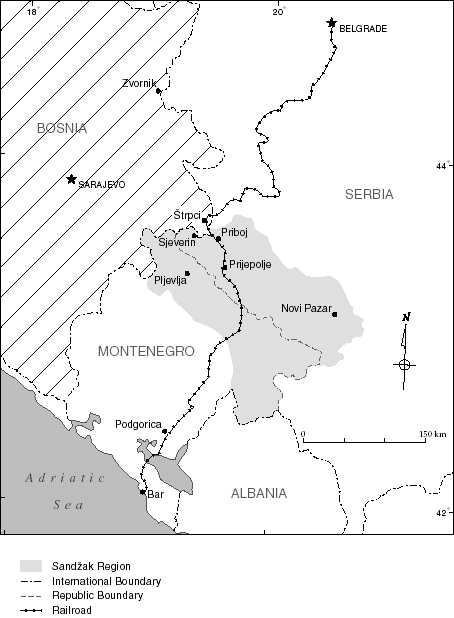SANDŽak'S STYMIED PARAMILITARIES
The Sandžak, divided between Serbia and Montenegro, is a mountainous region bordering on Bosnia with a population of some 500,000 split between Muslim Slavs, ethnic Serbs, and Montenegrins, with Muslims officially comprising slightly over 50 percent.[1] Strategically, Sandžak links Albania and Kosovo, to the east, with Bosnia, to the west. During the Bosnian war the region was a favorite jumping-off point for Serbian paramilitaries, who used its small, mountainous roads to quietly slip into Bosnia. Paradoxically, however, these gunmen did not systematically attack Muslims in the Sandžak itself.
Had institutional settings not mattered, Serbian officials are likely to have encouraged Serbian irregulars to ethnically cleanse the region. Authorities worried that a thriving Sandžak Muslim secessionist movement, allied to the nearby Bosnian Muslim Party of Democratic Action (SDA), might eventually form the centerpiece of the so-called Green Belt, an allegedly hostile, Muslim-controlled arc encircling Serbia on three sides. As one Serbian military journal warned, Muslim Slavs coveted Sandžak as "the important link of the Muslim chain that should connect the Islamic centers Sarajevo and Istanbul."[2] Sandžak, moreover, was Serbia's only

Map 3. Within the Serbian core: The Sandžak
Serbian fears of Sandžak secession and rebellion were not entirely unfounded. Sandžak's Muslims, like those of Bosnia, identified themselves politically as members of Yugoslavia's Muslim nationality, implying that
In Belgrade, the Serbian nationalist counter-elite had their own reasons for supporting Sandžak's ethnic cleansing. As was true for Kosovo, nationalists cherished Sandžak as a historical center of Serbian culture, politics, and religion, fearing that a politically self-confident Sandžak Muslim community posed a major threat to Serbia's heritage. During the 1980s, nationalist spokesmen such as Vuk Drašković placed Sandžak's Muslims high on their list of enemies, warning in February 1988 of the alleged "rage of offensive and intolerant Islam in Bosnia, Kosovo, and the Sandžak," as well as of the "vampire rebirth of" Islamic law and the "Jihad strategy of creating an Islamic state in the Balkans."[9] In 1990, Drašković organized a large demonstration in Novi Pazar, Sandžak's unofficial capital, warning Muslims their arms would be "cut off" if they dared raise a non-Serbian flag.[10] As Serbia's rulers became increasingly nationalistic themselves in the late 1980s and early 1990s, they increasingly referred to Sandžak as an integral part of Greater Serbia. Both Serbian officials and private Serbian nationalists, in other words, had reason to resent the Muslim presence in Sandžak, a fact recognized by concerned international actors when the Bosnian war began. The Organization for Security and Cooperation in Europe (OSCE) urgently deployed monitors to the region in 1993, responding to repeated warnings of impending genocide by Sandžak's Muslim leaders.[11]
Sandžak's Muslims, in sum, conceived of themselves as a distinct political